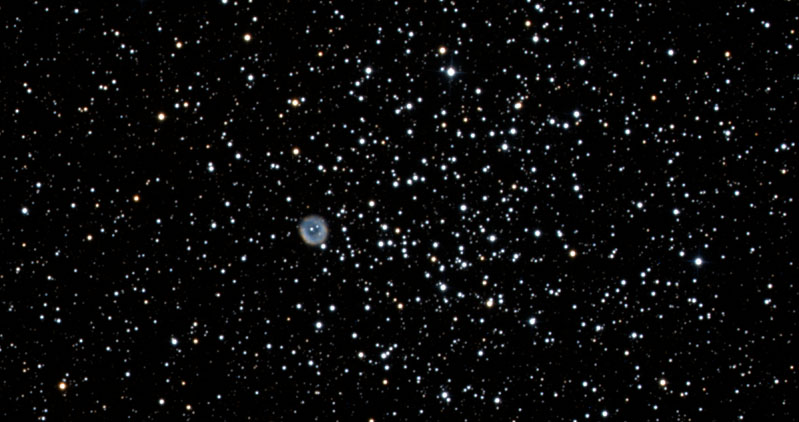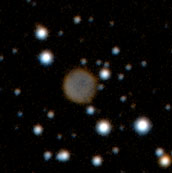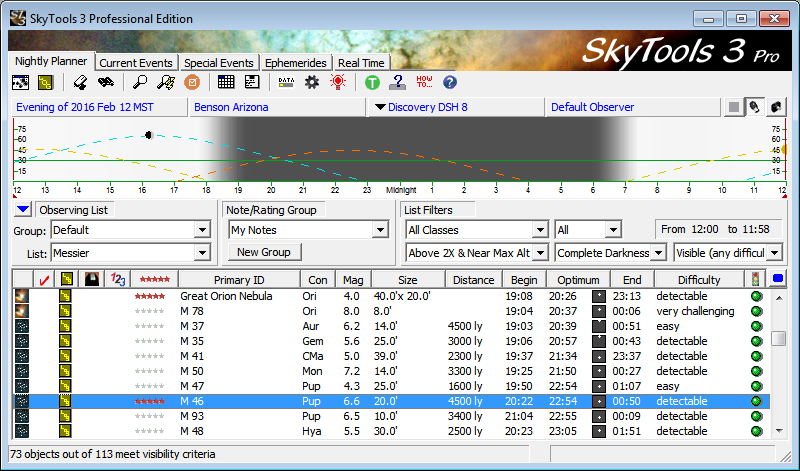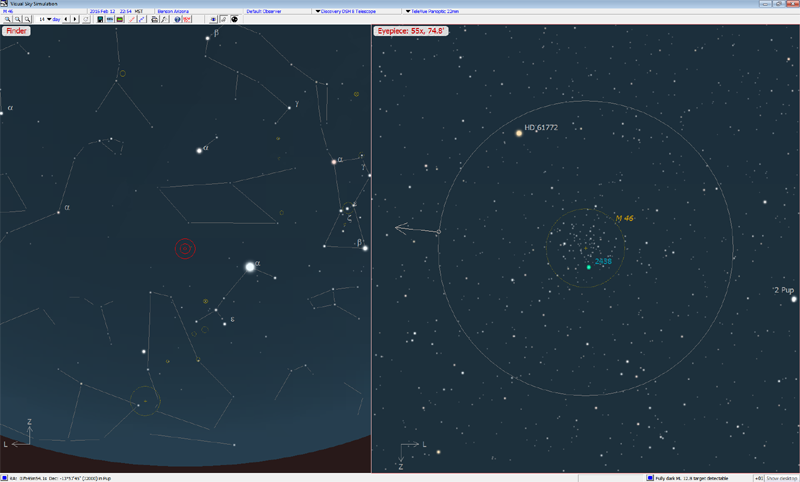

I
took this image of M46 and NGC 2438 with iTelescope
T21 on the nights of February 9th and 10th. I'm pretty happy
with it given that the total exposure time was only 15
minutes. This is a combination one five minute exposure in the Red
filter, and one ten minute exposure in the Blue. I used SkyTools 3 to
plan the observation. In addition to calculating the best times to
expose, SkyTools helped me determine that I should
expose twice as long in the blue filter than in the red to get a
color balanced image. All processing was done in Photoshop. The green
channel is a 50-50 combination of the red and blue. The color
balance is entirely natural. No adjustments were made. Click on
the image to see the full size version (look on the far left edge
for the smaller M 1-18 planetary nebula). North is to the left and
east is down.
The open cluster M46 is
one of my all-time favorite objects to observe. The view
of a small oval planetary nebula embedded in what Burnham's
describes as a "fine circular cloud of small stars"
always leaves me with a grin on my face. I saw M46 for the first
time in college when a fellow student (who is now a PhD
astronomer) showed it to me in a 21-inch telescope. It was
breathtaking.
By itself M46 is an excellent
open cluster, particularly for telescopes under 12 inches (30 cm). It
contains some 150 stars from 9th to 13th magnitude within a circle
of 30'. At a distance of 4500 light years, the stars are
contained within a region 40 light years across. This cluster can
be a bit difficult to find as it lies far from any bright constellation
stars, and the nearby larger and brighter open cluster M47 can
easily be mistaken for it. I always start from Sirius and look
along a line to the east roughly in the opposite direction of Beta
CMa. There is a ragged line of fainter stars, which I follow to
about twice the distance between Sirius and Beta CMa. But I've
been finding this thing most of my life. For those who haven't, a good finder chart will
help a lot.
The 10th magnitude planetary
nebula NGC 2438 was first noticed by William Herschel in 1786.
Small (1.1') and round, with some structure visible in larger
instruments, NGC 2438 lies about 7' to the north of the cluster
center. Look for a tiny hazy spot, as if one of the stars is out
of focus. Once you spot it, try higher magnification. The
planetary is located between us and the cluster of stars.
| The Hidden Gem
Another
planetary nebula lies a mere 30' north of the cluster.
Minkowski 1-18 is small (30") and faint, and few people know
about it. Without an OIII filter it is out of reach of
even an 18-inch telescope under dark skies. But the OIII
(and UHC) bring this planetary within reach of larger
amateur instruments. It's not clear what the
minimum aperture required is to see it, but based on my
observations I'd say that it should be detectable in a
14-inch (36 cm) scope, if not a 12 inch (30 cm). It
should be a real treat for those with access to 20-inch
or larger scopes.
I first observed this
smaller gem in my 18-inch Dob way back in 2001. My log
entry states: "With the OIII in place M 1-18 became
readily apparent at 166x and just bright enough to
sustain 430x with averted vision. It appeared round and
very diffuse; no obvious structure was seen. I had
the impression at times of a fairly sharp, slightly
ragged, edge. With the OIII removed I saw nothing.
|
 |
Planning
Your Observation

Note
that we have made the window as small as possible to fit the space
here.
The
SkyTools 3 Nightly Planner is set up (above) for February 12 at
Benson Arizona for an 8-inch (20 cm) Dobsonian telescope. The
good old standard Messier observing list is loaded. M46 is
selected. The red-dashed line in the graphic at the top displays
the altitude of M46 during the night. The teal line is the
altitude of the moon. The shading is the actual brightness of the
sky taking into account moonlight, twilight, etc. Just by looking
at the line we can see that the best time to observe M46 will be
between 22:00 and 23:00. But how much effect will the moon have on
it? In fact the moon is a waxing crescent and not all that bright.
For observing the stars in M46, SkyTools has calculated that you
can go ahead and start looking at 20:22 (the Begin column in the
planner). The best view will be at 22:54, and the good views will
last until 00:50, when it is low enough in the sky that we are
looking through too much air, which dims the stars and blurs them
due to atmospheric turbulence.
Click
on the image below to see a full size printable finder chart (pdf)
that was made by
right-clicking on M46 in the planner. These charts are customized
for the telescope and finding device to show the same stars you
will see in the sky, finder, and eyepiece.

The
left side shows the naked-eye sky with Rigel QuikFinder
circles at the location of M46. On the right is the view in
a wide field eyepiece. The orientation and magnitude limits are calculated for the time and location, including light
pollution, twilight, and moonlight.
Greg Crinklaw — Developer of
SkyTools
SkyTools
3, because the astronomy matters.
Read
more about SkyTools 3
|